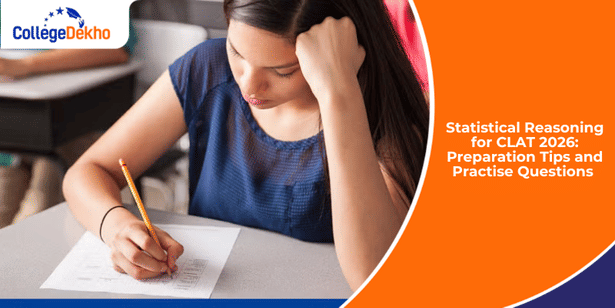
Statistical Reasoning for CLAT 2026 may be a small portion in terms of weightage, but performing well in this section can be the difference between a decent score and an excellent score. Statistics or Data Interpreation in CLAT 2026 is part of the Quantitative Techniques section, and it mainly includes questions with Charts, Tables, Histograms & other Graphical Information. To tackle this portion of the exam, you must improve your observation skills since identifying patterns in numerical data is crucial for statistical questions.
Also Read:
Practice Questions for Statistical Reasoning in CLAT 2026
Practice questions for CLAT quant statistics can be found in mock tests, previous year papers, and various other sources. You can check out some practice questions for statistical reasoning in CLAT 2026 below:
A company’s sales (in ₹ lakhs) over 5 months are:
Month | Jan | Feb | Mar | Apr | May |
|---|---|---|---|---|---|
Sales | 20 | 25 | 30 | 35 | 40 |
Q: What is the percentage increase in sales from January to May?
Solution: Increase = 40 − 20 = 20; % increase = (20/20)×100 = 100%.
Answer: 100%.
A survey of 200 students shows preferred study hours:
- 0–2 hrs: 50
- 2–4 hrs: 80
- 4–6 hrs: 40
- 6+ hrs: 30
Q: What fraction of students study more than 4 hours?
Solution: 40 + 30 = 70 → 70/200 = 7/20.
Answer: 7/20.
The marks of 5 students in the CLAT mock test are: 72, 85, 90, 65, 88.
Q: Find the average marks.
Solution: Sum = 72 + 85 + 90 + 65 + 88 = 400 → Average = 400/5 = 80.
Answer: 80.
In a class, the male-to-female ratio is 7:5. If the total students = 60, how many are female?
Solution: Total parts = 7 + 5 = 12 → 1 part = 60/12 = 5 → Females = 5×5 = 25.
Answer: 25.
Branch | Students | Passed | Failed |
|---|---|---|---|
A | 50 | 40 | ? |
B | 60 | 45 | ? |
C | 40 | 30 | ? |
Q: What is the overall pass percentage?
Solution: Total students = 50+60+40=150; Passed = 40+45+30=115 → Pass% = (115/150)×100 ≈ 76.67%.
Answer: 76.67%.
A line graph shows the population (in thousands) of a town over 5 years: 2018=50, 2019=55, 2020=60, 2021=68, 2022=72.
Q: Which year had the highest population growth rate?
Solution: Growth rates:
-
2018–19: (55−50)/50×100 = 10%
-
2019–20: (60−55)/55×100 ≈ 9.09%
-
2020–21: (68−60)/60×100 ≈ 13.33%
- 2021–22: (72−68)/68×100 ≈ 5.88%
Answer: 2020–21.
A bag contains 4 red, 5 blue, and 6 green balls. One ball is drawn randomly.
Q: Probability of drawing a red or green ball?
Solution: Total balls = 4+5+6=15 → Favorable = 4+6=10 → P = 10/15 = 2/3.
Answer: 2/3.
Product | Sold Units | Price/ unit (₹) | Revenue (₹) |
|---|---|---|---|
X | 120 | 50 | ? |
Y | 80 | 75 | ? |
Z | 100 | 60 | ? |
Q: Which product generated the highest revenue?
Solution: Revenue = Units × Price/unit → X=6000, Y=6000, Z=6000 → Tie.
Answer: All equal.
Preparation Tips for Statistical Reasoning in CLAT
Check out these preparation tips and how they will help you during CLAT below:
Tip | How It Helps | Example / Application |
|---|---|---|
Analyze Trends | Helps quickly answer line graph or growth questions | Identifying the highest population growth in consecutive years |
Cross-Check Totals | Reduces errors in calculations | Summing row/column totals in tables to verify data |
Focus on Time Management | Allocate 1–2 mins per question to avoid delays | Skip very complicated graphs initially, return if time permits |
Interpret Ratios Correctly | Ensures proportion-based questions are solved accurately | Male:female ratios in class → calculate actual numbers |
Practice Averages & Percentages | Most questions involve mean, percentage, or ratio calculations | Calculating the pass percentage from a student table |
Practice Past Year Papers | Familiarize yourself with CLAT question patterns | Previous CLAT Statistical Reasoning sets |
Regular Mock Practice | Builds speed, accuracy, and confidence under exam conditions | 15–20 min mini practice sets on tables/graphs |
Understand Data Types | Recognize whether it’s a table, graph, or chart for faster interpretation | Pie charts for percentage distribution, bar graphs for comparisons |
Use Approximation | Speeds up calculations and avoids minor errors | √9801 ≈ 99, quick estimation saves time |
Use Elimination | Helps if unsure, common in multiple-choice settings | Cross-check which options are impossible based on totals |
Hopefully, your statistical reasoning preparation for CLAT 2026 was improved through this article! Check out the links below to learn more!
Related Articles:
For any admission-related guidance, call our toll-free number 1800-572-9877, or fill out our Common Application Form (CAF) . Stay tuned with CollegeDekho for more updates related to UG/PG admission and colleges!
Are you feeling lost and unsure about what career path to take after completing 12th standard?
Say goodbye to confusion and hello to a bright future!

FAQs
Strategies for CLAT graph and table interpretation include: analyzing headings, calculating totals/averages, spotting trends, using approximations, cross-checking ratios, eliminating impossible options, and prioritizing easy questions for time efficiency.
Yes, the approximation method is useful in CLAT statistical questions. It speeds up calculations for percentages, averages, and ratios, reduces minor errors, and helps quickly eliminate options in multiple-choice questions under time pressure.
Statistical Reasoning in CLAT 2026 carries roughly 10–12% weightage, typically 12–15 questions out of 120. These test data interpretation, averages, percentages, ratios, and probability, often presented via tables, graphs, charts, or short caselets.
CLAT statistical questions include tables, graphs, charts, percentages, averages, ratios, probability, trend analysis, and comparison problems. They test interpretation, calculation, and reasoning rather than advanced mathematics, often in real-life or caselet formats.
Yes, you can skip Statistical and Data Interpretation questions in CLAT 2026. However, that is not recommended since these questions are usually moderate in difficulty and time-consuming, carrying 10–15% weightage. Skipping them may cost easy marks that boost your overall score. A better strategy is to attempt easy-to-moderate sets first and revisit harder ones if time permits.
Was this article helpful?




















Similar Articles
Documents Required to Fill CLAT 2026 Application Form: Photo Specifications, Scanned Images
CLAT 2026 Application Form Link: Last Date (Extended), Steps to Apply, Documents Required, Application Fee
CLAT 2026 Application Form Correction: Dates & Instructions
CLAT Login 2026: Forgot Password, Username, Steps to Retrieve
Legal Maxims for CLAT 2026: History and Modern-Day Applications
How to Crack CLAT 2026 'Assertion-Reason Questions'